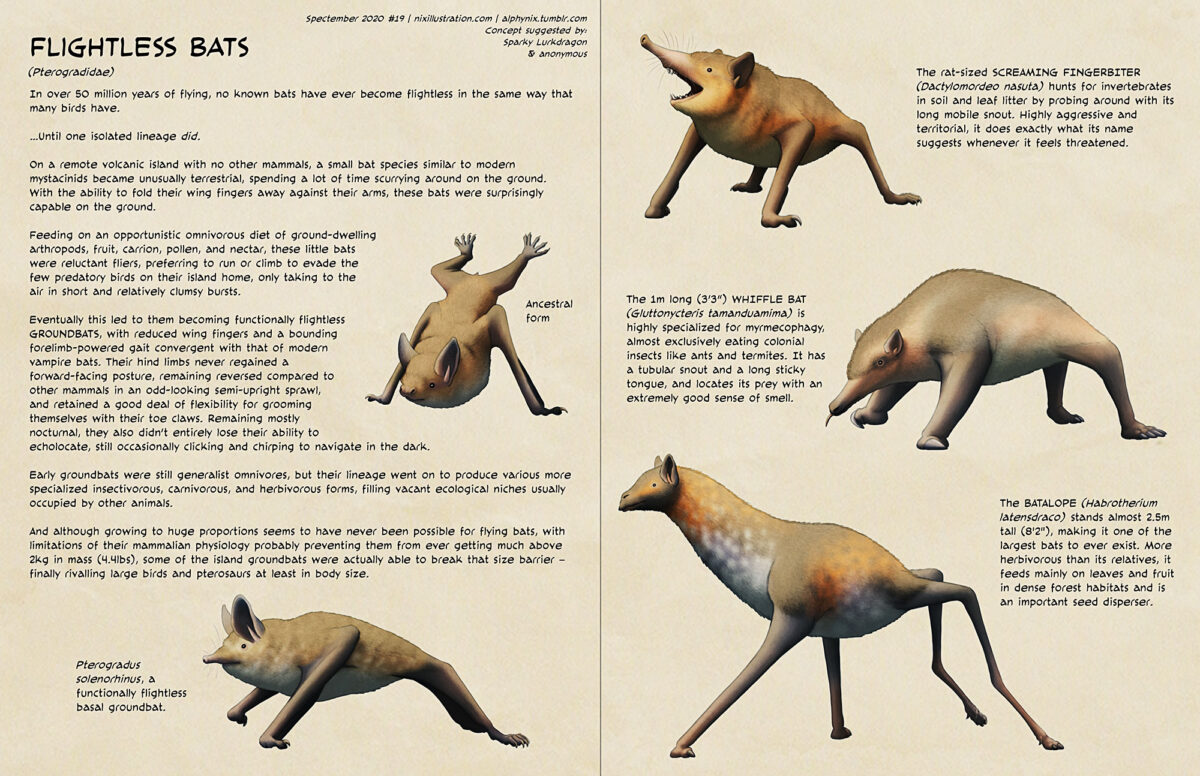(Giant Flightless Bats From The Future are bit of a specevo meme, so of course I had to include some this month.)
Transcript for the text on the image under the cut:
PAGE 1
Spectember 2020 #19 | nixillustration.com | alphynix.tumblr.com
Concept suggested by:
Sparky Lurkdragon
& anonymous
Flightless Bats
(Pterogradidae)
In over 50 million years of flying, no known bats have ever become flightless in the same way that many birds have.
…Until one isolated lineage did.
On a remote volcanic island with no other mammals, a small bat species similar to modern mystacinids became unusually terrestrial, spending a lot of time scurrying around on the ground. With the ability to fold their wing fingers away against their arms, these bats were surprisingly capable on the ground.
Feeding on an opportunistic omnivorous diet of ground-dwelling arthropods, fruit, carrion, pollen, and nectar, these little bats were reluctant fliers, preferring to run or climb to evade the few predatory birds on their island home, only taking to the air in short and relatively clumsy bursts.
[Image: a small bat crawling on all fours, with with wings folded up and its legs facing backwards.]
Ancestral form
Eventually this led to them becoming functionally flightless GROUNDBATS, with reduced wing fingers and a bounding forelimb-powered gait convergent with that of modern vampire bats. Their hind limbs never regained a forward-facing posture, remaining reversed compared to other mammals in an odd-looking semi-upright sprawl, and retained a good deal of flexibility for grooming themselves with their toe claws. Remaining mostly nocturnal, they also didn’t entirely lose their ability to echolocate, still occasionally clicking and chirping to navigate in the dark.
Early groundbats were still generalist omnivores, but their lineage went on to produce various more specialized insectivorous, carnivorous, and herbivorous forms, filling vacant ecological niches usually occupied by other animals.
And although growing to huge proportions seems to have never been possible for flying bats, with limitations of their mammalian physiology probably preventing them from ever getting much above 2kg in mass (4.4lbs), some of the island groundbats were actually able to break that size barrier – finally rivalling large birds and pterosaurs at least in body size.
[Image: a descendant of the small bat with reduced wing fingers and a tubular nose, walking on all fours.]
Pterogradus solenorhinus, a functionally flightless basal groundbat.
PAGE 2
[Image: a flightless bat with a very long shrew-like snout and sharp fang-like teeth.]
The rat-sized SCREAMING FINGERBITER (Dactylomordeo nasuta) hunts for invertebrates in soil and leaf litter by probing around with its long mobile snout. Highly aggressive and territorial, it does exactly what its name suggests whenever it feels threatened.
[Image: a groundbat that resembles an anteater or echidna, with stout limbs, large claws, and a tubular snout with a long tongue.]
The 1m long (3’3”) WHIFFLE BAT (Gluttonycteris tamanduamima) is highly specialized for myrmecophagy, almost exclusively eating colonial insects like ants and termites. It has a tubular snout and a long sticky tongue, and locates its prey with an extremely good sense of smell.
[Image: an almost giraffe-like groundbat with very long slender limbs, hoof-like claws, a long neck, and a pointed semi-prehensile upper lip.]
The BATALOPE (Habrotherium latensdraco) stands almost 2.5m tall (8’2″), making it one of the largest bats to ever exist. More herbivorous than its relatives, it feeds mainly on leaves and fruit in dense forest habitats and is an important seed disperser.


The batalope’s legs look too spindly to support itself.